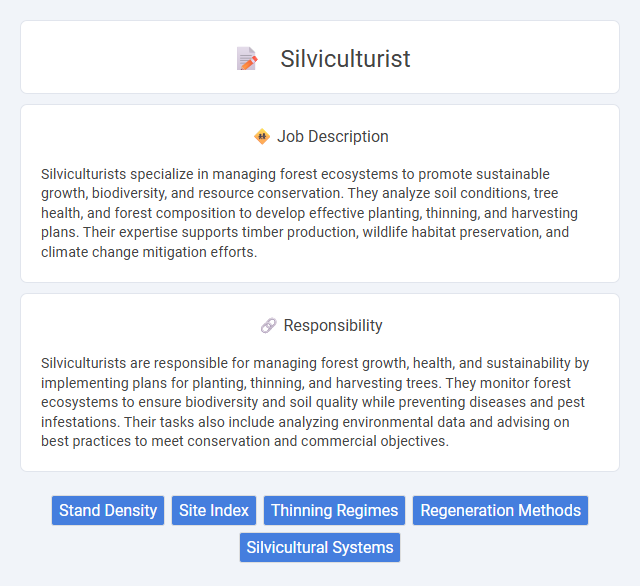
Silviculturists specialize in managing forest ecosystems to promote sustainable growth, biodiversity, and resource conservation. They analyze soil conditions, tree health, and forest composition to develop effective planting, thinning, and harvesting plans. Their expertise supports timber production, wildlife habitat preservation, and climate change mitigation efforts.
Individuals who enjoy working outdoors and have a strong interest in forestry and environmental conservation are likely to be well-suited for a silviculturist role. Those comfortable with physical labor, scientific research, and long-term project planning may find this career rewarding and fulfilling. People who prefer routine office work or minimal physical activity might find the demands of silviculture less compatible with their preferences and abilities.
Qualification
Silviculturists require a minimum of a bachelor's degree in forestry, environmental science, or natural resource management to manage and conserve forest ecosystems effectively. Advanced knowledge in tree biology, ecology, and forest management techniques is essential, often supported by certifications such as the Society of American Foresters' Certified Forester credential. Practical experience through internships or fieldwork enhances skills in implementing silvicultural treatments, monitoring forest health, and promoting sustainable forestry practices.
Responsibility
Silviculturists are responsible for managing forest growth, health, and sustainability by implementing plans for planting, thinning, and harvesting trees. They monitor forest ecosystems to ensure biodiversity and soil quality while preventing diseases and pest infestations. Their tasks also include analyzing environmental data and advising on best practices to meet conservation and commercial objectives.
Benefit
Silviculturist jobs likely offer significant benefits such as contributing to sustainable forest management and promoting biodiversity. Employees in this role may enjoy outdoor work environments and opportunities to influence conservation practices. Salary and job stability could also be attractive due to increasing demand for forest resource management expertise.
Challenge
Silviculturists likely face the challenge of managing forest ecosystems amid changing climate conditions that affect tree growth and health. Balancing economic, ecological, and recreational demands on forests may require constant adaptation and innovative techniques. Their work might also involve addressing pest infestations and diseases that threaten forest sustainability.
Career Advancement
A Silviculturist career offers opportunities for advancement through gaining expertise in forest management, ecosystem restoration, and sustainable timber production. Progression often involves moving into senior roles such as Forest Manager, Conservation Scientist, or Environmental Consultant, where leadership and project management skills are crucial. Pursuing advanced degrees or certifications in forestry and environmental science enhances prospects for higher-level positions within governmental agencies, research institutions, or private forestry companies.
Key Terms
Stand Density
Silviculturists specialize in managing forest stand density to optimize tree growth, health, and biodiversity. They apply techniques such as thinning and selective harvesting to maintain ideal stand density, preventing overcrowding and reducing competition for resources. Effective stand density management enhances timber quality, promotes sustainable forest ecosystems, and supports long-term productivity goals.
Site Index
Silviculturists assess Site Index to evaluate forest productivity by measuring the height of dominant trees at a specific age, which guides forest management decisions. Accurate Site Index data optimizes tree species selection, spacing, and thinning practices, enhancing timber yield and forest health. This metric is crucial for sustainable forestry, enabling precise growth predictions and adaptive silvicultural treatments.
Thinning Regimes
Silviculturists design and implement thinning regimes to improve forest health, increase biodiversity, and optimize timber production. By selectively removing specific trees, thinning regimes reduce competition for resources, enhance growth rates, and decrease the risk of disease and wildfire. These practices are tailored to tree species, stand age, and site conditions to ensure sustainable forest management and ecological balance.
Regeneration Methods
Silviculturists specialize in using various regeneration methods such as natural seeding, planting, coppicing, and shelterwood cutting to restore and maintain healthy forest ecosystems. These professionals analyze stand conditions and soil quality to select the most effective regeneration technique that promotes sustainable growth and biodiversity. Mastery of regeneration methods ensures forest resilience, supports wildlife habitats, and contributes to timber production goals.
Silvicultural Systems
Silviculturists design and implement silvicultural systems to manage forest regeneration, growth, composition, and health for sustainable timber production and ecological balance. Key silvicultural systems include clearcutting, shelterwood, selection, and coppice methods, each tailored to specific forest types and management objectives. Expertise in these systems enables silviculturists to optimize forest productivity, biodiversity conservation, and long-term ecosystem resilience.
 kuljobs.com
kuljobs.com